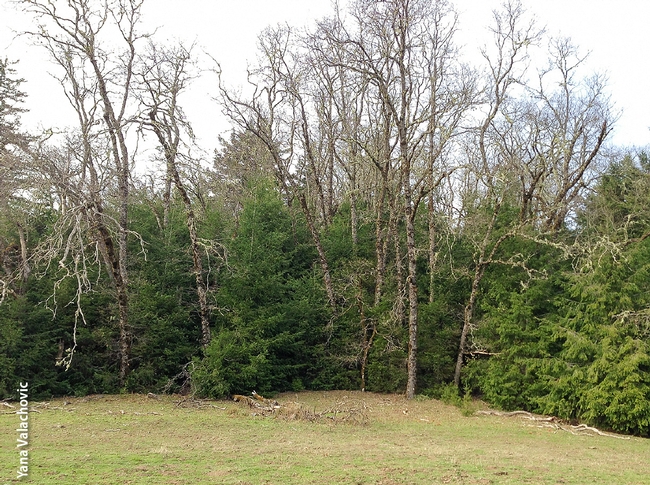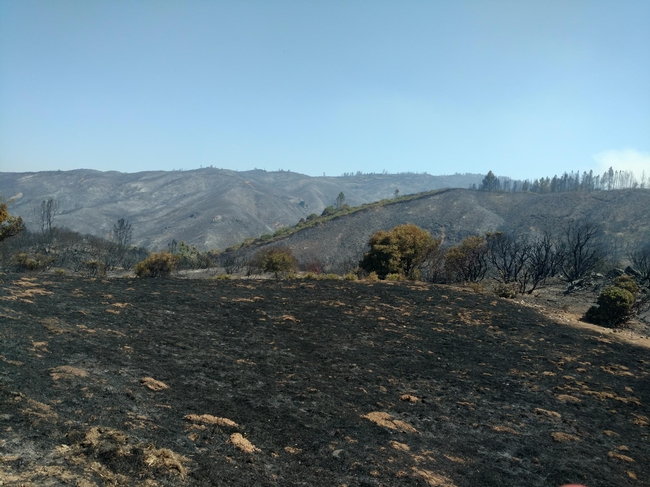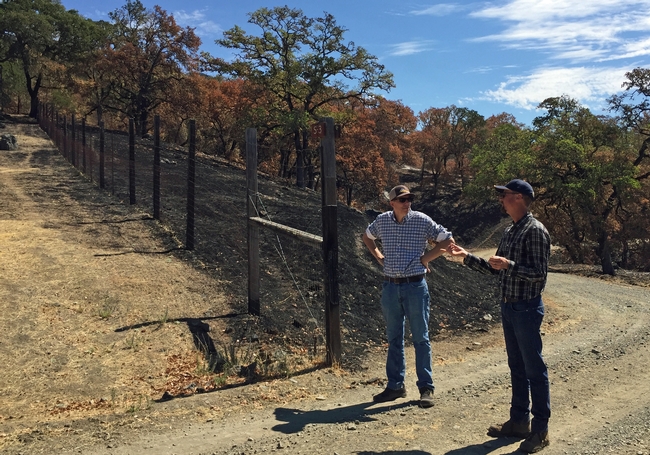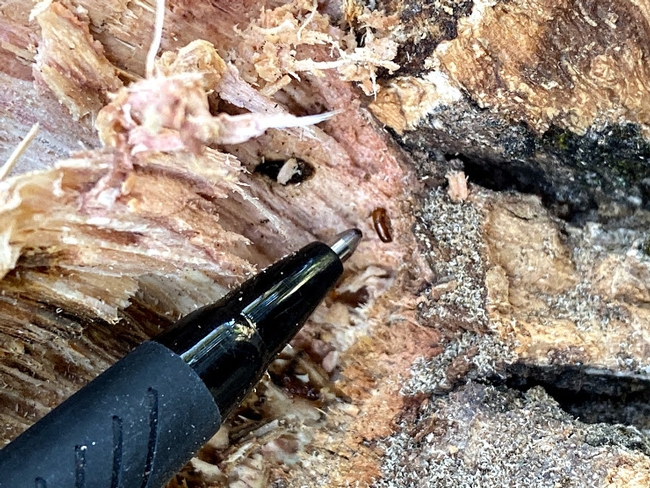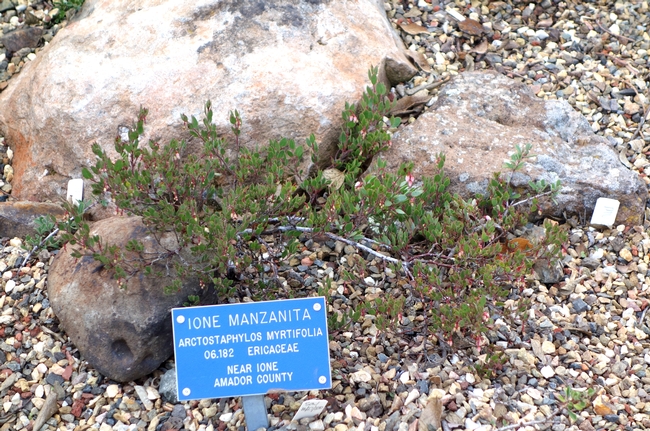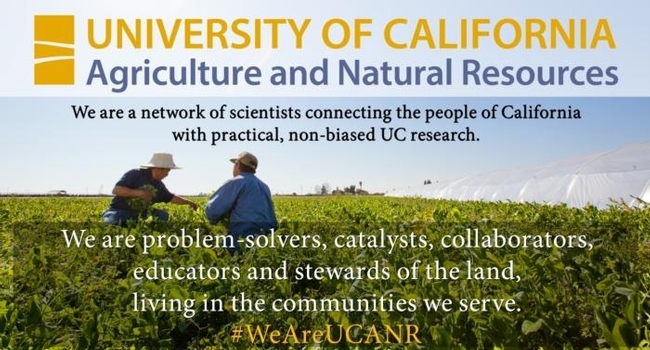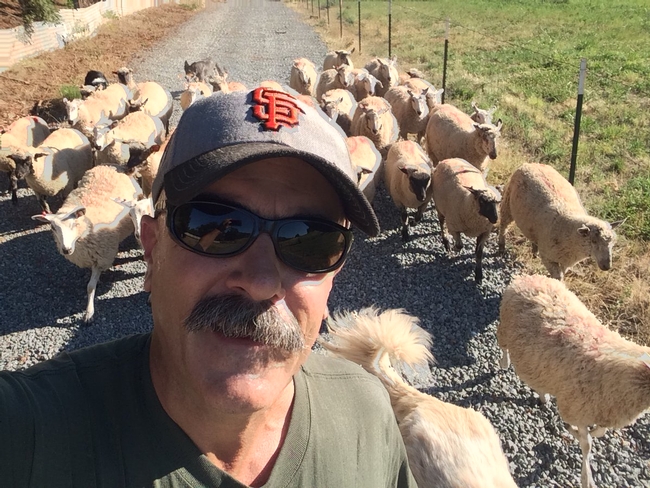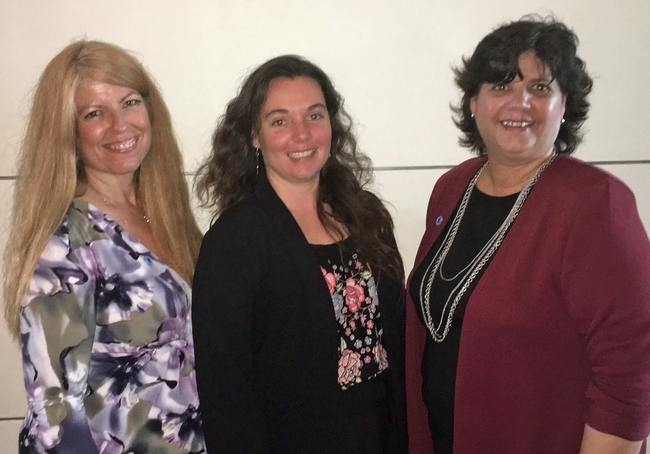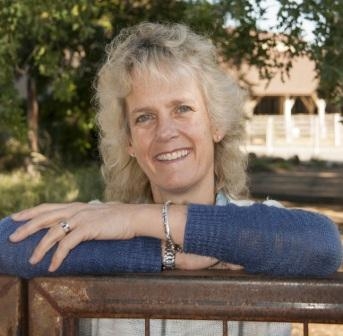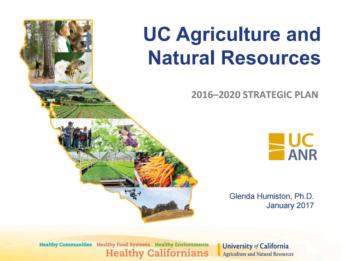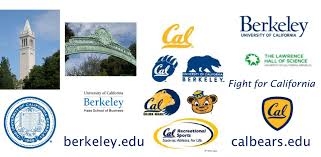Posts Tagged: Oak Woodlands
Hundreds sign up for online oak woodland workshop
California oak woodlands are highly prized ecoregions where stately trees, many of them hundreds of years old, are cornerstones of a habitat for wildlife and native plants. Sadly, some of these ecosystems are seriously threatened by exotic pests and diseases, encroachment by less desirable vegetation, and wildfire.
Each year, UC Cooperative Extension hosts workshops to share scientific developments aimed at conserving these important habitats – and the economic value of ranching – on oak woodlands, which are found on the lower elevation slopes of the Sierra Nevada, the Coast Range and other foothill areas of California.
Typically, the workshops are held in person and draw moderate-sized audiences for presentations, questions and answers, and field trips. Because of the COVID-19 pandemic, this year's workshop was offered online in April with pre-recorded presentations available for viewing at the participants' convenience and a live question-and-answer session on Zoom.
The retooled event garnered 500 registrants, over 300 views of the YouTube videos and 140 participants in the live Q&A session. The presentations and Q&A session are still available online for future viewing as well.
“People from all walks of life participated, including those with professional and personal interest in oak woodlands,” said Yana Valachovic, UCCE forest advisor in Humboldt and Del Norte counties and a conference organizer.
Presentations at the 2020 conference included the following topics:
Encroachment by Douglas-fir
In Northern California, the biodiversity of oak woodlands is being threatened by Douglas-fir encroachment. The oaks' shade helps the young conifers get established with protection from harsh sun. In time, the fast-growing Douglas-fir trees pierce the oak canopies and begin to crowd out the areas' native understories, which are important for the diversity of birds, mammals and reptiles attracted to oaks.
As the Douglas-fir continue to grow and multiply, they threaten the very lives of the oak trees and the unique ecosystem they dominate.
To better understand the Douglas-fir encroachment, Valachovic established 10 research sites in Humboldt and Mendocino counties to gather information about the fate and the age of oaks. She and her research partners determined the ages of the oaks and firs, and counted the seedlings, saplings, snags and understory vegetation.
“With this research, we were able to demonstrate that even though the oak trees can be smaller in diameter they are much older than the Douglas-fir trees,” Valachovic said. “The encroachment process is happening quickly, and the oaks are falling out of the system.”
The shift appears to have been initiated in the mid-19th and early-20th centuries, coinciding with the Gold Rush and wildfire suppression.
With the data confirming Douglas-fir encroachment, Valachovic turned her attention to oak woodland restoration. At 14 sites in Humboldt and Trinity counties, her team studied the effects of Douglas-fir removal.
“Grasses and forbs under the oaks reestablished. Diameter growth on the oaks increased,” she said.
These research findings contributed directly to changes in policy that had previously limited land owners' ability to remove and sell conifers encroaching on oak woodland. The research also helped create new funding opportunities to support oak woodland restoration and conservation in Northern California.
Case study of oak woodland wildfire recovery
In July 2018, about two-thirds of the 5,289-acre UC Hopland Research and Extension Center was burned by the River Fire.
The transformation of the land, which had likely been without a large wildland fire for at least 100 years, was intense and stressful, said UC Cooperative Extension forest advisor Michael Jones. However, it also provided a unique opportunity for researchers to compare the impact of wildfire on the resiliency of vegetation on grazed and ungrazed oak woodland.
Jones established 35 one-fifth acre research plots at the research center and collected data two months following the fire and one year later. The research will continue in the future to better understand long-term impacts, but Jones was able to share revealing early results at the workshop.
Right after the fire, in severely burned areas areas, the future of the oaks looked ominous. Jones predicted 40% tree mortality.
“The oaks were exposed to persistent, intense heat. They were cooked,” he said. “But two months after the fire, we were already seeing basal sprouts. This was an amazing response by the trees. Oaks are pretty damn tough.”
A year after the fire, surveys showed that tree mortality in the burned areas was 25%, much less than Jones' early predictions. While some management for specific situations in severely burned areas may be necessary – such as removal of hazard trees, reducing fuels in defensible spaces or removal to control invasive species – the results of this work show the trees recover naturally.
“Esthetically, I know these systems aren't as pleasing as they were before, but ecologically, they are healthy and recovering,” he said. “In 100 years, it will look just as good as before the fire.”
Fire impacts in woodland areas previously grazed and not grazed
The fire on the research station also permitted Jones to compare the fire's differing impact on non-grazed and grazed oak woodland. At first, the grazed areas looked almost unscathed with minimal flame scorching on the bark, while an area where the pasture hadn't been grazed for 25 years had evidence of much higher severity fire.
“Grazing is a phenomenal way to help manage fuels,” Jones said. However, the grazed areas displayed ecological shortcomings a year later.
“In grazed pastures, the large mature trees were still alive, but there was no oak regeneration (basal sprouting or seedlings),” Jones said. “In the ungrazed area, a lot of biomass had been killed, but there's nearly 100% resprout of oak trees and we have an impressive amount of oak seedling recruitment.”
Jones said he isn't discouraging grazing.
“But it is important to protect sites from grazing, and especially wildlife browse, when a landowner or land managers' objectives are to regenerate or conserve oak woodlands,” Jones said.
New ambrosia beetle another threat to California oaks
Akif Eskalen, UC Cooperative Extension specialist in the Department of Plant Pathology at UC Davis, has identified a new insect-fungus team that causes oak borer wilt in Northern California Valley and Blue Oaks. It is an ambrosia beetle, commonly known as Mediterranean Oak Borer, which carries several fungi in its mouth. The beetle bores into the tree and introduces fungi to grow for food. The fungi spreads and disturbs the transportation of water and nutrients, causing wilt in the tree.
The oozing and staining lesions on the bark are similar to other oak fungal diseases, such as Sudden Oak Death. The beetle – native of Mediterranean basin countries in Africa, Asia and Europe – cannot fly far, so most likely is transported for long distances on infested firewood.
During the workshop, Eskalen suggested not moving firewood, removing heavily infested trees and chipping infested wood into 1-inch particles to reduce the spread of the ambrosia beetle and its fungal partner. He asked viewers to report any suspected oak tree infestations to the local agricultural commissioner, CDFA Diagnostic Laboratories, UC Cooperative Extension advisors or CALFIRE. Chemical options for sparing oaks from the ambrosia beetles' devastation are under investigation.
Threats to oaks and other native plants from root rotting Phytophthora
Restoration plantings have inadvertently introduced plant pathogens to native oak woodland ecosystems in California, said Ted Swiecki of Phytosphere Research, an organization that provides consulting services related to natural resource management, horticulture, urban forestry, and agriculture. The group of pathogens causing the damage are largely from the Phytophthora genus, first described in the 1860s. The name translates from Greek to “plant destroyer.”
Swiecki has observed when Phytophthora infested plants and soils are introduced to native habitats, the pathogens can attack various native plants, including toyon, madrone, manzanita and full-grown oaks. Once established, the pathogen can spread along drainages, by moving soil from one area to another and by hitchhiking on equipment, tires and hiking boots.
The pathogen can easily be overlooked at nurseries, which, by their nature, have conditions that favor Phytophthora development. Plants at nurseries are well watered, have high root density and are often placed on the ground where they can pick up pathogens.
He said the best approach to tackling Phytophthora is not using nursery stock for restoration or beautification of natural oak woodland. Direct seeding, using natural regeneration, or onsite propagation are safer ways to enhance vegetation in oak woodland.
“It's easier to prevent Phytophthora from being introduced in the first place and much cheaper and more effective than trying to eradicate it later,” Siewcki said.
'We are UC ANR' public awareness campaign launches
A month-long public awareness campaign titled "We are UC ANR" launched June 1. The campaign was designed to help those who have struggled to wrap their arms around all that UC ANR does. It features two new website products: A three-minute video that explains UC ANR's origins and current activities, and an interactive map that shows the locations of UC ANR programs across the state.
The communications team is asking everyone – UC ANR staff and academics, farmers, 4-H members, volunteers, agency representatives and all other stakeholders – to share their ANR stories through social networks, with the hashtag #WeAreUCANR. To make this easy, the team developed a toolkit that includes sample posts and tweets, images, short video trailers and messaging.
We are all problem-solvers, catalysts, collaborators, educators and stewards of the land. UC ANR is a bridge between the people of California and trusted, science-based answers to everyday questions. Please help us bring UC ANR alive to current and future stakeholders.
We are UC ANR webpage (with video and map)
We are UC ANR social media toolkit
Names in the News
Macon named livestock and natural resources advisor
Daniel Macon has accepted the livestock and natural resources advisor position in Placer, Nevada, Sutter and Yuba counties, effective July 1.
Macon, who operates a small-scale commercial sheep enterprise near Auburn, brings a combination of hands-on livestock production experience and applied scientific research and education/outreach experience.
Having been the herdsman at the UC Sierra Foothill Research and Extension Center, and most recently serving as an associate specialist for rangeland science and management in the UC Davis Plant Sciences Department, Macon is a familiar face to many in ANR. He is currently collaborating on a variety of research efforts, including on-ranch impacts, management and planning horizons following California's historic drought. He has also led producer enrollment, data collection and grazing-water-nutrient management tracking for a statewide integrated research and extension project on irrigated pasture. He is also leading a long-term project that will quantify direct and indirect impacts from predators on rangeland livestock operations across northern California.
Macon has also worked for the Natural Resources Conservation Service and the California Cattlemen's Association, and was the founding executive director of the California Rangeland Trust. He is currently the vice president of the California Wool Growers Association and is a past president of the California-Pacific Section of the Society for Range Management.
Macon earned a Master of Agriculture in integrated resource management from Colorado State University and a Bachelor of Science in agricultural and managerial economics from UC Davis.
“I have finally recognized that the parts of my earlier jobs that I most enjoyed involved the things I'll be doing on a daily basis as a farm advisor - teaching and doing research,” Macon wrote in his Foothill Agrarian blog. “Along with raising sheep, I feel as though I've finally figured out what I'm supposed to do in life!”
“I have enormous shoes to fill - Roger Ingram and Glenn Nader, who have proceeded me in these four counties, were incredibly productive and successful advisors.”
Macon will be based in the Auburn office and can be reached at (530) 889-7385 and dmacon@ucanr.edu. Follow him on Twitter at @flyingmulefarm and Instagram at @flyingmule.
Spinelli named vegetable and irrigation advisor
Gerardo “Gerry” Spinelli joined UCCE on April 17 as an area vegetable production and irrigation advisor for Stanislaus, San Joaquin and Merced counties.
Before joining UCCE, Spinelli had worked as agricultural specialist for the Resource Conservation District of Santa Cruz County since 2015. He performed irrigation system evaluations, implemented an irrigation water and soil moisture monitoring project, and provided recommendations for irrigation management and improvements in irrigation systems, assisting the strawberry, lettuce, apple, vegetable and blackberry industries.
From 2010 to 2015, Spinelli was a graduate student researcher in the Plant Sciences Department at UC Davis, where his research focused on water stress and water use at the leaf and canopy level in almond orchards in California.
Spinelli grew up on an olive and vegetable farm on the hills overlooking Florence, Italy. He left Italy in 2007 to work in Honduras on an irrigation development project providing technical assistance for smallholder corn and watermelon growers, and in London designing and installing landscape irrigation systems. He also lived in Lebanon, where he introduced integrated pest management in apple and olive production, rebuilt irrigation channels for tobacco and vegetable growers, implemented a queen bee breeding program and built sewage lines for the Wavel refugee camp. In addition to English, he speaks French, Italian and Arabic.
Spinelli earned a Ph.D. in horticulture and agronomy and a M.S. in international agricultural development from UC Davis and a M.S. in tropical agricultural development and a B.S. in agricultural sciences and technologies from the University of Florence, Italy.
Based in Modesto, he can be reached at (209) 525-6806, (530) 304-3738 (cell) and gspinelli@ucanr.edu.
Vela to lead News and Information Outreach in Spanish
Ricardo Vela joined UC ANR as manager of News and Information Outreach in Spanish (NOS) on May 15. As NOS manager, he oversees production of UC ANR radio, video and news releases for Spanish-language news media and will advise academics on effective outreach to the Latino community.
Before joining UC, Vela was the news director and main anchor for KVER-TV Univision in Palm Springs. Vela launched his journalism career in the third grade by starting a school newspaper in Ciudad Juarez, Mexico. He was the news correspondent for Univision News in Los Angeles bureau for over 10 years, then moved to San Diego where he was the news anchor/producer for the Univision affiliate for 14 years. In 2014, Vela moved to his hometown of El Paso, Texas, to be the news anchor/producer for KTDO-Telemundo 48.
In 1992, he won an Emmy for his story about a Latino family coping with their last days before dying of AIDS and preparing their children for their loss. In 2005, Vela received an Emmy for a news feature, “Los Trovadores del Siglo 21.”
In 2001, Hispanic Business Magazine named Vela one of the 100 most influential Hispanic journalists in the country for his journalistic vision to voice the needs of the Hispanic community in San Diego. He expanded his commitment to the community by writing a weekly column for the El Latino newspaper about issues pertinent to Hispanics in San Diego. In 2004, The San Diego Press Club honored his newspaper column and morning radio talk show, Voces de San Diego, which had been on the air only a few months, and he was named one of the 10 most influential Latinos in San Diego by Tijuana's Frontera newspaper.
On Feb. 28, 2006, the City of San Diego honored him with a proclamation of “Ricardo Vela Day” for his contributions to the Latino community through his radio show.
Vela earned a bachelor's degree in business administration at Instituto Tecnologico de Ciudad Juarez, Mexico, and a bachelor's degree in mass communications/journalism at the University of Texas at El Paso. He also studied film and video at the Art institute in Chicago.
Vela is based at the Rubidoux Building in Riverside and can be reached at (951) 781-2151 and ricardo.vela@ucr.edu.
ANR women graduate from UC Women's Initiative Program
Valerie Borel, Jan Gonzales, Margaret Lloyd, Robin Sanchez and Katherine Soule recently graduated from the UC Women's Initiative for Professional Development.
They were among a group of mid-career women, both staff and faculty, selected from all UC locations to participate in this special program created to improve the professional development and advancement of women at UC.
The four-session program was designed by the Systemwide Advisory Committee on the Status of Women and UC Systemwide Talent Management, and delivered by CORO, a nonprofit leadership development organization.
The UC Women's Initiative's four in-person, interactive, multi-day sessions have been designed to:
- Cultivate a vibrant, professional network of women that spans the UC system
- Give women access to top UC leaders—women and men—so they can interview and learn from them about their diverse leadership approaches and journeys
- Strengthen participants' skills and confidence through hands-on practice with a range of tools and skills in the areas of:
- Professional development and impact
- Strategic relationship building
- Developing and delivering a compelling narrative regarding one's professional accomplishments and vision
- Negotiating at work
- Peer coaching
The program is designed for mid-career women, both faculty and staff, who demonstrate the potential to advance their careers at UC. Last year, Katherine Webb-Martinez and Tunnyalee Martin participated in the training.
For more information about the program, visit the UC Women's Initiative website at http://ucop.edu/human-resources/womens-initiative.
Van Eenennaam tapped for national research strategy
Alison Van Eenennaam, UCCE genomics and biotechnology specialist in the Department of Animal Science at UC Davis, has been named to a national committee to lead the development of an innovative strategy for the future of food and agricultural research.
The National Academies of Sciences, Engineering and Medicine sought nominations for scientific leaders across various disciplines to be part of an activity that will develop a compelling strategy for food and agricultural research for the next decade and beyond. Nominations were sought for transformational thinkers across the scientific enterprise (including but not exclusively limited to the agricultural sciences) to be considered for the study committee. These include individuals on the frontier of scientific disciplines that would be of value but are not traditionally associated with food and agriculture.
In addressing its statement of task, the study committee will offer a strategic and ambitious view of the opportunities for fundamental and applied interdisciplinary research that is both grounded by a deep scientific understanding of food and agricultural challenges and elevated by the breakthrough potential of insights and tools from newly converging disciplines in the food and agriculture setting.
Susan Wessler, the Neil A. and Rochelle A. Campbell Presidential Chair for Innovations in Science Education and distinguished professor of genetics at UC Riverside, is co-chair of the committee.
For more information about the study, visit http://nas-sites.org/dels/studies/agricultural-science-breakthroughs/who-we-are-agriculture-breakthroughs/committee.
UC ANR's Strategic Plan has its own website
A stand-alone website devoted to UC ANR's Strategic Plan is now live and can be accessed in various ways:
- Direct link: http://ucanr.edu/sites/anrstaff/2016-2020_Strategic_Plan/
- “Squished” link: http://ucanr.edu/strategicplan
- Mini URL: http://ucanr.edu/p/58630
- Keyword search of any ANR website for "strategic plan."
The website is designed to give UC ANR academics and staff updated information on the plan and its ongoing implementation, and their role in reaching the plan's goals. It's also a place where stakeholders can offer feedback to leadership. Please let your stakeholders know about the site.
For more information about the Strategic Plan, read AVP Wendy Powers' blog post Updates on implementation of the strategic plan.
Should you be using a new UC ANR logo? Probably not
This new look for the top-level brand is being rolled out slowly with digital implementation first. We know that folks have invested in signage, shirts, printed collateral materials and other durable items, and we're not going to ask that any of these items be changed. Additionally, the Brand Toolkit contains close to 1,000 assets—everything from logos to business cards to PowerPoint templates. Updating those assets is a daunting task and a challenging brand management issue.
This multi-level brand approach is not unprecedented. A good example is how UC Berkeley handles their brand package. There's a high-level brand for the campus and other sub-brands, like the script Cal and iterations of the Golden Bear. Each has a place in the brand family. This is especially applicable for well-recognized, even well-loved brands with a lot of brand equity—like the script Cal, the vintage bear, or even 4-H, UCCE, Master Gardener and others in our own brand package.
Over the coming weeks, as we roll out the re-design of the high-level pages of the website, you'll see the new ANR brand in action. If you need to order durable items there is no need to delay; feel free to use the current brand packages available in the Brand Toolkit. Future changes to the sub-brand packages will be minimal and won't be incorporated into the sub-brand packages for at least 8 to 12 months.

